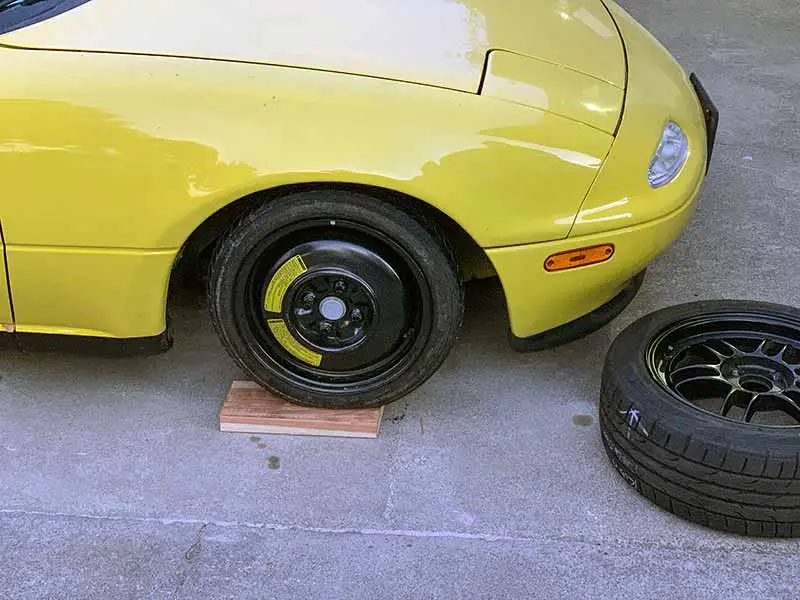Picture this: you’re driving along on a beautiful day, enjoying the scenery, when suddenly, you feel a jolt and hear a loud thud. Your car starts to wobble, and you realize you have a flat tire. In such a situation, knowing how to change a tire can save you time, money, and stress. In this blog post, we’ll guide you through the process of changing a flat tire, from determining “which way does a spare tire go on” to important safety tips and precautions.
Which Way Does a Spare Tire Go On?
It’s important to check for specific markers or labels on the tire itself. Also, consider valve stem position and directional tread patterns when mounting the tire. You can also check your vehicle’s owner’s manual for the correct orientation of the spare tire.
In this article we’ll walk you through the proper orientation and installation of a spare tire, highlighting the significance of factors like valve stem position and directional tread patterns. We’ll give you a comprehensive step-by-step guide on how to safely change a flat tire, from finding a secure location to park, to removing the flat tire, and finally, installing the spare.
We’ll delve into the differences between full-size and temporary spare tires, and underline the importance of routine spare tire maintenance. Lastly, we will provide safety tips and precautions to keep in mind when changing a tire, emphasizing the correct usage of tools and the value of seeking professional assistance when needed.
Let’s take a closer look.
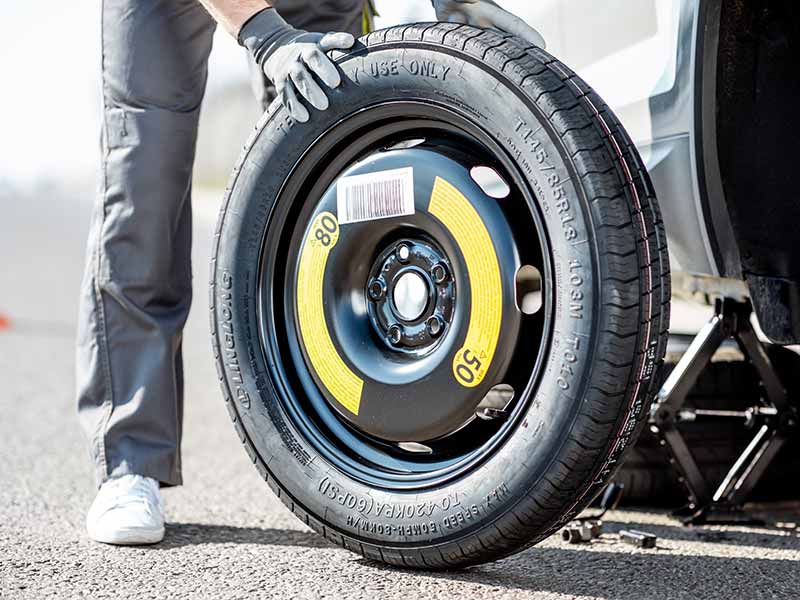
Determining the Correct Orientation of a Spare Tire
Before you can change a flat tire, it’s crucial to understand how to position the spare tire correctly on your vehicle. Proper placement of the spare tire directly affects the performance and safety of your car.
To ensure the correct orientation, you need to consider three key factors: valve stem position, directional tread patterns, and the owner’s manual’s specific instructions.
Valve Stem Position
The valve stem is a vital component of the tire, as it’s where you add or remove air and measure the air pressure with a tire gauge. When installing the spare tire, ensure the valve stem is facing outwards. This position allows easy access to the valve for inflating the tire and checking the air pressure.
Directional Tread Patterns
Some tires have directional tread patterns, designed to perform optimally when spinning in a specific direction. To identify a directional tire, look for an arrow on the tire sidewall pointing in one direction. It’s essential to mount the tire so that the tread follows the direction of the arrow when the car is moving forward. Failing to do so can lead to rapid wear, reduced handling, and increased noise while driving.
If your spare tire is not directional, you can mount it in any orientation. However, it’s still essential to ensure the valve stem is facing outwards for easy access.
Checking the Owner’s Manual
Your vehicle’s owner’s manual is an invaluable resource when it comes to mounting your spare tire. The manual provides specific instructions for your car’s make and model, including jack placement and lug nut torque specifications.
Always consult the owner’s manual before attempting to change a tire to ensure proper installation and prevent potential damage to your vehicle.
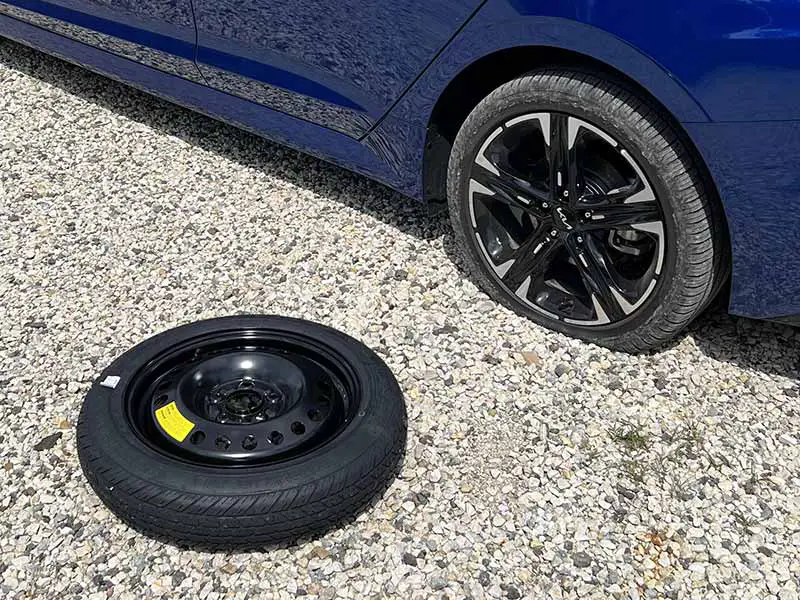
Steps to Change a Flat Tire
Now that you know how to position the spare tire correctly let’s explore the three main steps in changing a flat tire: safely parking and preparing your vehicle, removing the flat tire, and installing the spare tire. Each of these steps is crucial to ensuring a smooth and safe tire change.
In the following sections, we’ll cover each step in detail to give you a comprehensive understanding of the tire-changing process.
Safely Parking and Preparing Your Vehicle
First and foremost, it’s crucial to find a safe location to park your vehicle before attempting to change the flat tire. Look for a level, straight stretch of road with a wide shoulder, away from traffic. Turn on your hazard lights and place a reflective warning sign behind your car to alert other drivers.
Before you begin the tire-changing process, gather the necessary tools, including a jack, lug wrench, and wheel wedges. Consult your vehicle owner’s manual to locate the proper jack placement on your car’s frame, close to the flat tire. Position wheel wedges in front of or behind the tire opposite the flat to prevent the car from rolling while you work.
Removing the Flat Tire
To remove the flat tire, start by removing the wheel cover (if applicable) and loosening the lug nuts. Place the jack underneath the vehicle at the designated jacking point and carefully lift the car until the flat tire is about six inches off the ground. Keep in mind that safety is paramount during this step; never place any part of your body under the vehicle while jacking it up or after it’s raised.
Once the car is raised, use the lug wrench to remove the loosened lug nuts completely. Grasp the flat tire by the treads and gently slide it off the wheel hub. Set the old tire aside, ensuring it won’t roll or cause any hazards.
Installing the Spare Tire
With the flat tire removed, it’s time to install the spare tire. Align the holes on the spare tire with the wheel studs on the hub and slide the tire onto the studs until it’s flush against the hub. Replace the lug nuts by hand, tightening them as much as possible. Lower the car until the spare tire touches the ground but doesn’t bear the car’s full weight.
Use the lug wrench to tighten the lug nuts in a star pattern, ensuring even pressure across the wheel. Finally, lower the car completely and remove the jack. Double-check the lug nuts to ensure they are tightened securely.
Place the flat tire, jack, and lug wrench back in your trunk for proper storage.
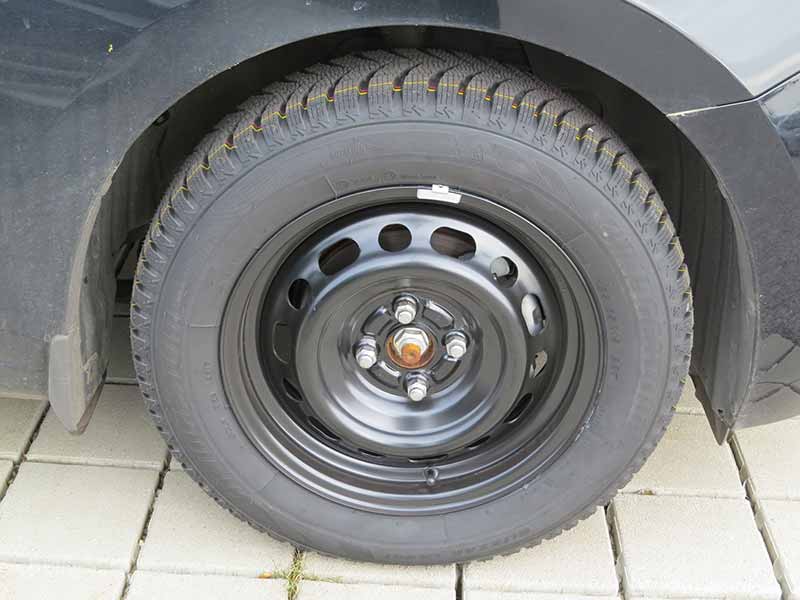
Spare Tire Types and Maintenance
Understanding the differences between full-size and temporary spare tires is essential for proper tire maintenance. In addition, regularly checking the air pressure in your spare tire ensures it’s ready for use when needed.
In this section, we’ll discuss the differences between full-size and temporary spare tires and the importance of maintaining your spare tire.
Full-Size vs. Temporary Spare Tires
Full-size spare tires are the same size as the other tires on your vehicle and are designed for longer-term use. On the other hand, temporary spare tires, often called “donuts,” are smaller and more compact, making them easier to store in your trunk.
These temporary spares are designed for short distances and should be replaced with a regular tire as soon as possible. Remember to drive slowly and cautiously when using a temporary spare tire.
Regularly Checking Spare Tire Pressure
It’s important to check your spare tire’s air pressure regularly, as an underinflated spare tire can be unsafe and lead to poor vehicle handling. At least once a month, or before a long highway drive, use a tire gauge to check the pressure in your spare tire and inflate it to the manufacturer’s recommended level.
Regular spare tire maintenance ensures it’s ready for use when needed and contributes to overall vehicle safety.
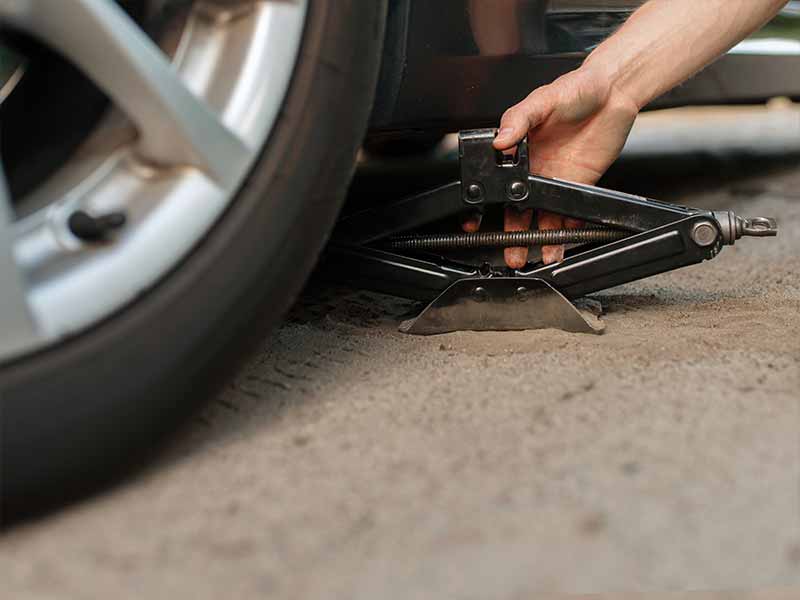
Safety Tips and Precautions When Changing a Tire
Changing a tire can be a straightforward process when done correctly, but it’s essential to prioritize safety at all times. In this section, we’ll cover the proper use of tools and equipment and the importance of seeking professional assistance if you’re unsure about any part of the tire-changing process.
Following these safety tips and precautions can help you change a tire confidently and safely.
Proper Use of Tools and Equipment
The proper use of tools and equipment is crucial for a safe and effective tire change. Using the right tools for the job, such as a lug wrench, jack, and wheel wedges, ensures safety and prevents damage to your vehicle. Always follow the vehicle owner’s manual for specific instructions on using these tools and the recommended torque pressure for tightening lug nuts.
In addition to using the correct tools, it’s important to practice caution when working near traffic. Turn on your hazard lights, place a reflective warning sign behind your car, and wear gloves to protect your hands while working.
Seeking Professional Assistance if Unsure
If you’re unsure about any part of the tire-changing process or feel uncomfortable attempting it, it’s always best to seek professional help. Roadside assistance services or auto mechanics can provide the necessary expertise to ensure a safe and proper tire change.
Remember, your safety and the safety of others on the road should always be the top priority.
Resources
Below are some links you may find helpful when learning about tires
Final Thoughts
We’ve covered the essential steps and precautions for changing a flat tire, from determining the correct orientation of a spare tire to the proper use of tools and equipment. We’ve also discussed the importance of understanding different spare tire types and the need for regular spare tire maintenance. By following these guidelines and safety tips, you can confidently and safely change a flat tire and get back on the road in no time.
As you embark on your future journeys, remember that knowledge is power. Equipped with the information and skills covered in this blog post, you can face any roadside emergency with confidence and self-assurance. So go forth and conquer the open road knowing that you’re prepared for anything that comes your way.
Good luck and happy motoring.
